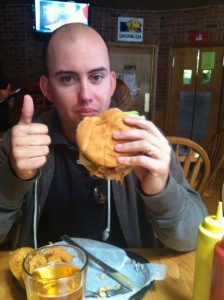The frictions between the Denver health types and the city’s restaurants are thoroughly covered in a feature by Lori Midson of Denver Westword News. Brief excerpts below:
On Wednesday, March 28, 2012, the first complaint came in. The Colorado Department of Public Health and Environment received a call from a diner who had recently eaten at Osteria Marco and claimed to have fallen ill because of that meal. The CDPHE reported the call to the Denver  Department of Environment and Health, the city agency that ensures Denver food-service establishments are in compliance with state and federal laws, as well as all city regulations.
Department of Environment and Health, the city agency that ensures Denver food-service establishments are in compliance with state and federal laws, as well as all city regulations.
The DEH sent investigator Thuy Vu and a rep of Denver Public Health to Osteria Marco; she initially noted that an “unknown pathogen” was the suspected culprit. But she would soon report that “based on interviews conducted by DPH, [the] suspected pathogen is norovirus or noro-like virus.”
Owner Frank Bonanno, one of Denver’s most successful restaurateurs, was out of town when the trouble started. Denver health officials were “demanding all of our OpenTable guest information, including phone numbers,” he says, and also requesting anal swabs from several Osteria employees. “DPH conducted interviews of two ill employees, both of whom refused the request from DEH and DPH to submit specimen samples from rectal swabs and bulk stool samples,” Vu noted.
In that same March 29 report, Vu detailed other critical violations she’d observed at Osteria Marco, including “bare hand contact on ready-to-eat foods, hands not washed as required, hand sinks used to dump customer water, use of unpasteurized raw shell eggs in cocktails, improper cold holding temperatures of potentially hazardous foods, and evidence of pests (fruit flies/phorid flies).” Moreover, she noted, the “general manager also reported that nine employees (kitchen and waitstaff) called in sick within five days,” in addition to “another large party” that “called the facility directly to complain about a separate, unrelated incident of foodborne illness.”
A follow-up inspection of Osteria Marco on March 30 resulted in a cease-and-desist order for bare-hand contact on ready-to-eat foods, as well as a request for the name of every other Bonanno employee who worked not just at Osteria Marco, but Mizuna, Bones, Luca d’Italia, Lou’s Food Bar, Russell’s Smokehouse and Green Russell. “During the course of the March 29 visit to Osteria Marco to investigate the illness complaint, the investigator learned that there were a number of employees who worked at Osteria  Marco and other Bonanno Concepts facilities who had recently been ill,” explains Danica Lee, food program manager at DEH and an official with whom the outspoken Bonanno already had a rocky relationship. (“Yes, Danica, I’m mean” was the start of one of Bonanno’s blog posts in May.)
Marco and other Bonanno Concepts facilities who had recently been ill,” explains Danica Lee, food program manager at DEH and an official with whom the outspoken Bonanno already had a rocky relationship. (“Yes, Danica, I’m mean” was the start of one of Bonanno’s blog posts in May.)
Bob McDonald, the city’s director of public-health inspections and a twenty-year veteran of the DEH, says his inspectors had every reason to look into Bonanno’s other establishments. “When Osteria’s outbreak came to my attention,” he adds, “I instructed inspectors to check out Frank’s other restaurants. With chains like that, it’s common that there are cross-employees.” …
In 2008, there were 9,003 food-service inspections conducted in the City and County of Denver, and the total fines collected amounted to $122,335; in 2009, the department inspected 7,811 food-service establishments, collecting $157,690. In 2010, the health department conducted 8,211 inspections, generating $118,995 in fines. But in 2011, when the Denver health department conducted 8,090 inspections, it managed to collect $731,900 in fines. And 677 restaurants were fined in 2011, compared to 315 in 2008. …
But as the fines increased, so did complaints from restaurants — particularly restaurants owned by Frank Bonanno. “Frank has a challenging personality,” McDonald says. “I would encourage him to spend as much energy focusing on correcting violations and keeping them corrected and less time on arguing and fighting with health inspectors, whose job it is to make food-service safety a priority.”…
While Bonanno, who regularly cooks at all of his restaurants, still gets cranky about some of the department’s policies, he and his staffs are doing everything they “possibly can to comply with the health department,” he says. “We have a checklist for every restaurant, and every day, the chef or the sous chef goes through the checklist and basically does an inspection of things that we used to get dinged for — making sure the hand sink is clean, making sure that gloves are available everywhere in the kitchen.
“If you stay on top of things, and if the health department is more understanding about what really makes people sick — none of us want to do that — then I think we can have a good relationship,” he adds. “I hope that 2013 is a better year for all of us.”
 This result may be counterintuitive but the authors back up their analysis of mathematical models of the spread of disease with actual recorded data from past outbreaks.
This result may be counterintuitive but the authors back up their analysis of mathematical models of the spread of disease with actual recorded data from past outbreaks.









